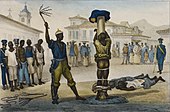Tawse
| Part of a series on |
| Corporal punishment |
|---|
 |
| By place |
| By implementation |
| By country |
| Court cases |
| Politics |
| Campaigns against corporal punishment |
A tawse, sometimes formerly spelled taws (commonly named "The Belt") (the plural of Scots taw, a thong of a whip) is an implement for corporal punishment. It was used for educational discipline, primarily in Scotland, but also in schools in the English cities of Newcastle Upon Tyne, Gateshead, Manchester and Walsall.
A tawse consists of a strip of leather, with one end split into a number of tails. The thickness of the leather and the number of tails varied. Many Scottish saddlers made tawses for local customers. The official name "tawse" was hardly ever used in conversation by either teachers or pupils, who instead referred to it as either the school strap or the belt, which is normally a term for an unforked implement, as worn in trousers (see belt).
The most effective tawse used by Scottish teachers was produced by three generations of the Dick family, a saddlers and leatherworkers based in Lochgelly, Fife. Their belts were made from hard and dense leather, split into two or three stiff tails at the business end to maximise the sting, and they came in a choice of light (L) , medium (M) , heavy (H) and extra heavy (XH) weights. Teachers selected their belt according to the age of the pupil to be punished and the severity of punishment that they wished to administer, thus L and M belts were commonly used to punish Primary school pupils, with H and XH belts chosen to strap Secondary school pupils.
Scottish public (state) schools used the tawse to punish pupils of either sex on the palm of the hand. They were usually instructed to hold out one hand, palm uppermost, and supported by the other hand, which made it difficult to move the hand away during the infliction of the cuts, and also ensured that the full force of each stroke was taken by the hand being strapped. The punishment was often inflicted in front of the class, to act as a deterrent to others.
In Walsall and Gateshead, and in some schools in Manchester, male students were tawsed on the seat of the trousers.
Some Scottish private (independent) schools also used the tawse, such as Keil School, but others such as Fettes College used the cane instead, in the way of most schools in England.
A 1982 judgment of the European Court of Human Rights about parental choice in education led indirectly to the use of the tawse (and that of all other forms of corporal punishment) being banned by law in UK state schools in 1987, but most Scottish local education authorities had already abolished it by the early 1980s.
Original Lochgelly tawses are now considered collectibles and may be sold for several hundred pounds each.
The tawse was also used for judicial corporal punishment in Scotland as an alternative to the more usual birch. Courts could sentence boys of over 14 but under 16 to up to 36 strokes with an extra-heavy tawse for any offence. This was administered to the offender's bare buttocks. Judicial corporal punishment was abolished in 1948.
Sources, References and External links
- The Cane and the Tawse in Scottish Schools, article at World Corporal Punishment Research
- The Belt (Factsheet 12), Heatherbank Museum of Social Work, Glasgow Caledonian University
